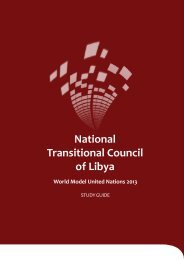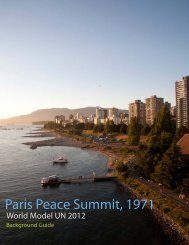Disarmament and International Security Committee (DISEC)World ...
Disarmament and International Security Committee (DISEC)World ...
Disarmament and International Security Committee (DISEC)World ...
Create successful ePaper yourself
Turn your PDF publications into a flip-book with our unique Google optimized e-Paper software.
economically. Sovereignty over the isl<strong>and</strong>s could<br />
decide who controls around 40,000 square kilometers<br />
of the surrounding continental shelf or exclusive<br />
economic zone (EEZ) area. This control would confer<br />
ownership of natural resources in the area, such as<br />
fisheries <strong>and</strong> potential oil <strong>and</strong> gas reserves. 23<br />
One of the main reasons the diaoyu isl<strong>and</strong>s<br />
have attracted so much political attention was the<br />
discovery of oil <strong>and</strong> gas. Before the discovery of oil<br />
<strong>and</strong> gas deposits in the area of the isl<strong>and</strong>s, China <strong>and</strong><br />
Japan had an indifferent attitude toward the Diaoyu/<br />
Senkaku Isl<strong>and</strong>s. 24 However, in 1968, the United<br />
Nations Economic Commission for Asia <strong>and</strong> the Far<br />
East suggested the possibility of large hydrocarbon<br />
deposits in the waters surrounding the diaoyu/<br />
Senkaku Isl<strong>and</strong>s. 25<br />
In addition to the economic <strong>and</strong> security benefits<br />
of the Diaoyu/Senkaku Isl<strong>and</strong>s, the dispute is difficult<br />
to resolve because of its political implications. China<br />
<strong>and</strong> Japan’s domestic politics <strong>and</strong> international status<br />
are directly related to the dispute over the islets. How<br />
each government h<strong>and</strong>les the dispute reflects on<br />
the legitimacy of the Chinese <strong>and</strong> Japanese central<br />
governments in domestic politics <strong>and</strong> on their foreign<br />
relations on the international stage. 26 Furthermore,<br />
how the Diaoyu/Senkaku Isl<strong>and</strong>s dispute is resolved<br />
will also serve as the blueprint for the resolution<br />
of other Chinese <strong>and</strong> Japanese maritime territorial<br />
disputes. 27<br />
Experts generally break the complicated Diaoyu/<br />
Senkaku Isl<strong>and</strong>s issue into three specific aspects:<br />
ownership of the isl<strong>and</strong>s, the return of the isl<strong>and</strong>s, <strong>and</strong><br />
the demarcation of maritime boundary. Regarding<br />
ownership, China <strong>and</strong> japan disagree on whether<br />
the isl<strong>and</strong>s were terra nullius (l<strong>and</strong> unclaimed) when<br />
Japan claimed sovereignty over the isl<strong>and</strong>s in 1895. 28<br />
Second, China <strong>and</strong> Japan dispute whether Japan<br />
returned the isl<strong>and</strong>s to China after the Japanese<br />
defeated in <strong>World</strong> War II. Lastly, China <strong>and</strong> Japan<br />
debate how their maritime boundaries are drawn in<br />
accordance to the United Nations Convention on the<br />
Law of the Sea (UNCLOS). 29<br />
Historical Developments<br />
Although the Sino-Japanese dispute over the<br />
Diaoyu/Senkaku Isl<strong>and</strong>s began when Japan annexed<br />
the isl<strong>and</strong>s in 1895, it was not until the late 1960’s that<br />
the dispute became a major issue in Sino-Japanese<br />
relations. 30 In 1969, the U.S. <strong>and</strong> Japan issued a<br />
Joint Statement that led to the Ryukyu Reversion<br />
Agreement signed in 1971. One of the provisions<br />
of the agreement stated that the Diaoyu/Senkaku<br />
Isl<strong>and</strong>s was a part of Okinawa <strong>and</strong> was to be returned<br />
to Japanese rule. 31 thous<strong>and</strong>s of Chinese students in<br />
the United States protested for several months <strong>and</strong><br />
expressed their concerns in an open letter to the u.S.<br />
President <strong>and</strong> Congress. 32 At the same time, both the<br />
People’s Republic of China on the Chinese mainl<strong>and</strong><br />
<strong>and</strong> the Republic of China (ROC) government in<br />
Taiwan disputed the claims. When, in 1970, Japan<br />
notified the ROC government that Taiwan’s claims to<br />
the isl<strong>and</strong>s were invalid, the Taiwanese government<br />
planted the ROC flag on the isl<strong>and</strong>s, <strong>and</strong> three<br />
members of Taiwan’s National Assembly visited the<br />
isl<strong>and</strong>s to signify their control over the isl<strong>and</strong>s. In<br />
June 1971, the Agreement Between Japan <strong>and</strong> the<br />
United States of America Concerning the Ryukyu<br />
isl<strong>and</strong>s <strong>and</strong> the daito isl<strong>and</strong>s was signed. All of the<br />
disputed Diaoyu/Senkaku isl<strong>and</strong>s were included in<br />
the areas returned to Japan. 33 Although initially with<br />
this signing the U.S. supported Japan’s claims, the<br />
U.S. shortly afterward took a neutral stance over the<br />
dispute, which at the time, was between the ROC <strong>and</strong><br />
Japan, because it wanted to improve relations with<br />
the People’s Republic of China. 34<br />
The period from the reversion of Okinawa <strong>and</strong><br />
Diaoyu/Senkaku isl<strong>and</strong>s to Japanese rule in 1972<br />
to today is characterized by a series of encounters<br />
followed by periods of inactivity. One of the first<br />
13<br />
Melbourne Host Directorate PTY LTD | Office of Media <strong>and</strong> Design
















